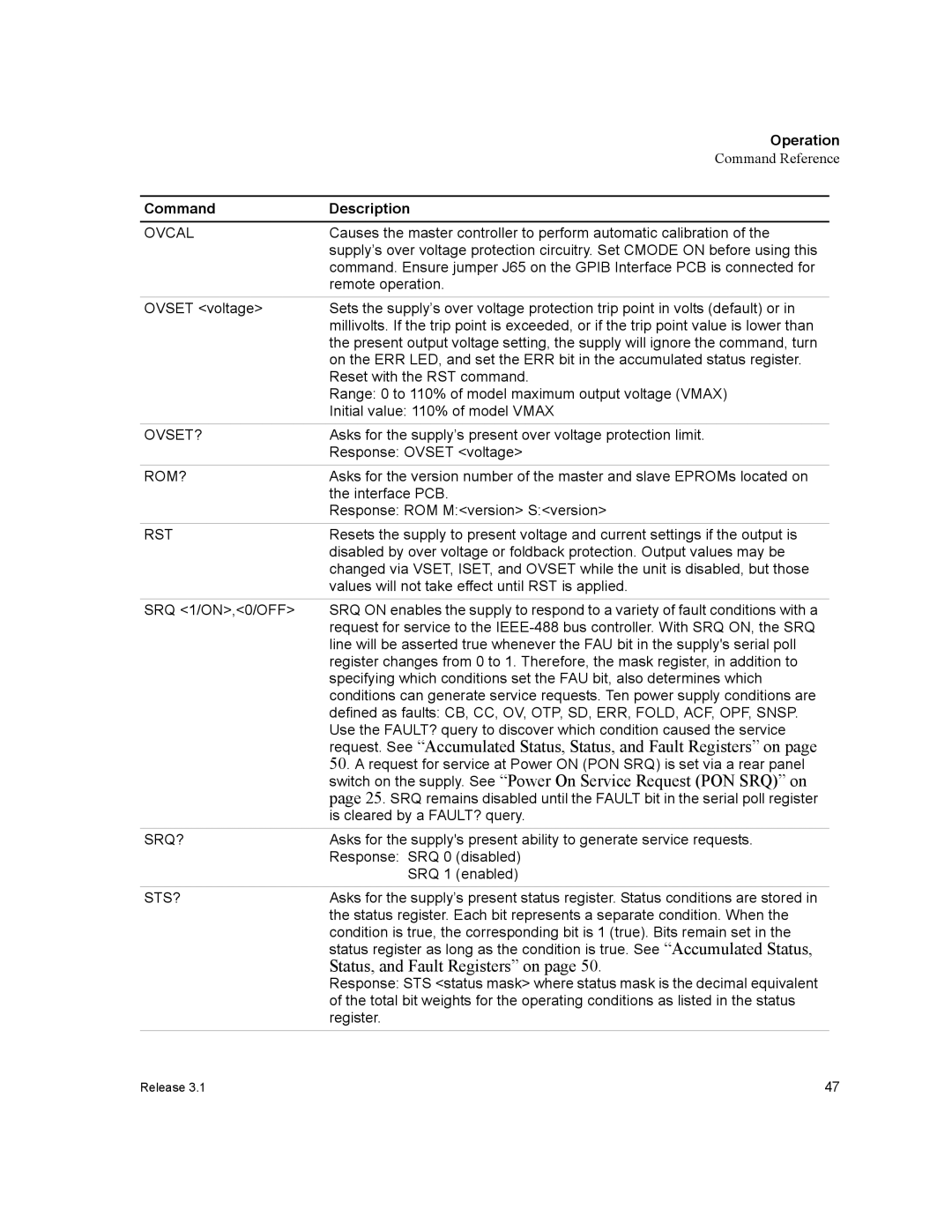| Operation | |
| Command Reference | |
|
|
|
Command | Description |
|
OVCAL | Causes the master controller to perform automatic calibration of the | |
| supply’s over voltage protection circuitry. Set CMODE ON before using this | |
| command. Ensure jumper J65 on the GPIB Interface PCB is connected for | |
| remote operation. |
|
OVSET <voltage> | Sets the supply’s over voltage protection trip point in volts (default) or in | |
| millivolts. If the trip point is exceeded, or if the trip point value is lower than | |
| the present output voltage setting, the supply will ignore the command, turn | |
| on the ERR LED, and set the ERR bit in the accumulated status register. | |
| Reset with the RST command. | |
| Range: 0 to 110% of model maximum output voltage (VMAX) | |
| Initial value: 110% of model VMAX |
|
OVSET? | Asks for the supply’s present over voltage protection limit. | |
| Response: OVSET <voltage> |
|
ROM? | Asks for the version number of the master and slave EPROMs located on | |
| the interface PCB. | |
| Response: ROM M:<version> S:<version> |
|
RST | Resets the supply to present voltage and current settings if the output is | |
| disabled by over voltage or foldback protection. Output values may be | |
| changed via VSET, ISET, and OVSET while the unit is disabled, but those | |
| values will not take effect until RST is applied. |
|
SRQ <1/ON>,<0/OFF> | SRQ ON enables the supply to respond to a variety of fault conditions with a | |
| request for service to the | |
| line will be asserted true whenever the FAU bit in the supply's serial poll | |
| register changes from 0 to 1. Therefore, the mask register, in addition to | |
| specifying which conditions set the FAU bit, also determines which | |
| conditions can generate service requests. Ten power supply conditions are | |
| defined as faults: CB, CC, OV, OTP, SD, ERR, FOLD, ACF, OPF, SNSP. | |
| Use the FAULT? query to discover which condition caused the service | |
| request. See “Accumulated Status, Status, and Fault Registers” on page | |
| 50. A request for service at Power ON (PON SRQ) is set via a rear panel | |
| switch on the supply. See “Power On Service Request (PON SRQ)” on | |
| page 25. SRQ remains disabled until the FAULT bit in the serial poll register | |
| is cleared by a FAULT? query. |
|
SRQ? | Asks for the supply's present ability to generate service requests. | |
| Response: SRQ 0 (disabled) | |
| SRQ 1 (enabled) | |
|
|
|
STS? | Asks for the supply’s present status register. Status conditions are stored in | |
| the status register. Each bit represents a separate condition. When the | |
| condition is true, the corresponding bit is 1 (true). Bits remain set in the | |
| status register as long as the condition is true. See “Accumulated Status, | |
| Status, and Fault Registers” on page 50. | |
| Response: STS <status mask> where status mask is the decimal equivalent | |
| of the total bit weights for the operating conditions as listed in the status | |
| register. |
|
Release 3.1 | 47 |
